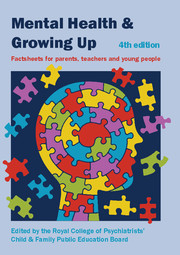Book contents
- Frontmatter
- Contents
- Contributors
- Factsheets for young people
- Factsheets for parents, carers and anyone who works with young people
- 1 Good parenting
- 2 The restless and excitable child
- 3 Dealing with tantrums
- 4 Children who soil or wet themselves
- 5 Sleep problems in childhood and adolescence
- 6 Behavioural problems and conduct disorder
- 7 Attention-deficit hyperactivity disorder (ADHD)
- 8 The child with general learning disability
- 9 Specific learning difficulties
- 10 Autism and Asperger syndrome
- 11 Depression in children
- 12 Worries and anxieties: helping children to cope
- 13 Divorce or separation of parents: the impact on children and adolescents
- 14 Death in the family: helping children to cope
- 15 The emotional cost of bullying
- 16 Traumatic stress in children
- 17 Domestic violence: its effects on children
- 18 Child abuse and neglect: the emotional effect
- 19 Drugs and alcohol: what parents need to know
- 20 Self-harm in young people
- 21 Psychosis
- 22 Schizophrenia
- 23 Bipolar disorder in children and adolescents
- 24 Obsessive–compulsive disorder in children and young people
- 25 Eating disorders in young people
- 26 Chronic physical illness: the effects on mental health
- 27 Medically unexplained physical symptoms
- 28 Chronic fatigue syndrome: helping your child get better
- 29 Parental mental illness: the problems for children
- 30 Who's who in CAMHS
14 - Death in the family: helping children to cope
from Factsheets for parents, carers and anyone who works with young people
Published online by Cambridge University Press: 02 January 2018
- Frontmatter
- Contents
- Contributors
- Factsheets for young people
- Factsheets for parents, carers and anyone who works with young people
- 1 Good parenting
- 2 The restless and excitable child
- 3 Dealing with tantrums
- 4 Children who soil or wet themselves
- 5 Sleep problems in childhood and adolescence
- 6 Behavioural problems and conduct disorder
- 7 Attention-deficit hyperactivity disorder (ADHD)
- 8 The child with general learning disability
- 9 Specific learning difficulties
- 10 Autism and Asperger syndrome
- 11 Depression in children
- 12 Worries and anxieties: helping children to cope
- 13 Divorce or separation of parents: the impact on children and adolescents
- 14 Death in the family: helping children to cope
- 15 The emotional cost of bullying
- 16 Traumatic stress in children
- 17 Domestic violence: its effects on children
- 18 Child abuse and neglect: the emotional effect
- 19 Drugs and alcohol: what parents need to know
- 20 Self-harm in young people
- 21 Psychosis
- 22 Schizophrenia
- 23 Bipolar disorder in children and adolescents
- 24 Obsessive–compulsive disorder in children and young people
- 25 Eating disorders in young people
- 26 Chronic physical illness: the effects on mental health
- 27 Medically unexplained physical symptoms
- 28 Chronic fatigue syndrome: helping your child get better
- 29 Parental mental illness: the problems for children
- 30 Who's who in CAMHS
Summary
How does a child respond to death?
How children react to death depends on a number of factors.
• How close the person who died was to the child, and the family, is important and how involved that person was in their lives.
• Whether the death was sudden or expected (a relief from suffering or a crushing blow). How traumatic it was can have an impact on how children cope with it.
• The circumstances of the death also affect the impact it has on the child. Each family responds in its own way to death. Religion and culture will have an important influence on what happens.
Other factors that can make a big difference from the child's point of view are:
• the effect of grief on other family members, especially if they are not able to cope with giving the child the care they need
• how much practical support is available to help the family cope.
How do children of different ages understand death?
The child's age and level of understanding can affect how the death affects their life. Infants may feel the loss because it affects the way in which they are looked after and their daily routine. They are very sensitive to the unhappy feelings of those around them, and may become anxious, difficult to settle and more needy of attention.
Pre-school children usually see death as temporary and reversible, a belief reinforced by cartoon characters that ‘die’ and ‘come to life’ again.
Children from about the age of 5 are able to understand basic facts about death:
• it happens to all living things
• it has a cause
• it involves permanent separation.
They can also understand that dead people do not need to eat or drink and do not see, hear, speak or feel. Most children get angry and worried, as well as sad, about death. Anger is a natural reaction to the loss of someone who was essential to the child's sense of stability and safety. A child may show this anger in boisterous play, by being irritable, or in nightmares. Anxiety is shown in ‘babyish’ talk and behaviours that can include demanding food, comfort and cuddles.
Young children believe that they cause what happens around them. They may worry that they caused the death by being naughty.
- Type
- Chapter
- Information
- Mental Health and Growing UpFactsheets for Parents, Teachers and Young People, pp. 87 - 89Publisher: Royal College of PsychiatristsPrint publication year: 2013



